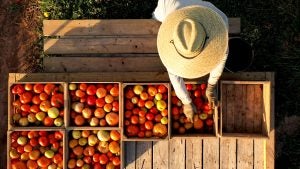Agriculture is a vital part of our economy, both in the United States and all around the world. In the U.S., we produce a wide variety of agricultural products and luckily, a surplus of these products. Everyone likes choices, so in order to have a huge variety of products on our grocery store shelves, the U.S. imports products that often can’t be grown or produced here. We also export products, which generates a lot of revenue for the United States and plays a big role in our economy.
Here’s an overview of everything you need to know about agricultural exports in the United States.
The United States exported $178.7 billion worth of agricultural products in 2023. (Ag exports peaked in 2022, hitting $196 billion. In 2019, ag exports made up 6.4 percent of all exports made by the United States.) Four categories of products accounted for about 90 percent of total agricultural exports in 2023: grains and feeds, oilseeds and their product, animals and meats, and horticultural products.
The U.S. exports a lot of surplus grains, oilseeds such as soybeans, and meat products. Over the last 10 years there’s been a rise in exports of fruits and vegetables.

There are a few reasons that ag exports decreased in 2023 from 2022. There was a decrease in exports across all commodities, but especially grains and animal and meat exports. This is due to the lower prices and values for corn, wheat, sorghum and beef, and impacts were felt on exports across all sectors of ag.
Exports make up a large share of what is produced in American agriculture. Since 2013, the share of U.S. ag and food production sold in international markets has been around 20 percent of all U.S. ag production value. Among the many products that make up U.S. agricultural trade, the USDA’s Economic Research Service (ERS) estimates that about 23 percent of the output of non-manufactured agricultural products and 21 percent of manufactured agricultural products were exported between 2013 and 2022. Non-manufactured products include grains like rice and wheat, oilseeds, and tree nuts such as almonds. Manufactured products include sweeteners, bakery products, and dairy products.
Since one fifth of agricultural products are exported, it’s important to consider how much we need ag exports. Ag exports have also been on the rise. From 2013 to 2023, U.S. ag exports increased at an annual rate of 2.1 percent.
Ag exports also play a big role in economic activity and job creation. The ERS estimates that each dollar of agricultural exports in 2022, another $1.09 in business activity was created. This means that the $197.4 billion of agricultural exports in 2022 produced an additional $214.6 billion in economic activity, which is a total economic output of $412 billion.
Exports also create jobs. Each $1 billion of U.S. agricultural exports in 2022 supported 6,338 jobs in the United States. As a total in 2022, ag exports supported 1.25 million full-time jobs, of which 773,900 jobs are in the non-farm sector.

The U.S. exports to countries all over the world. The top 5 markets for ag exports made up 64 percent of all U.S. ag exports in 2023. Exports to China were the largest share at $33.7 billion, followed by Mexico at $28.2 billion and Canada at $27.9 billion. The European Union accounted for $12.3 billion of exports, which is slightly more than Japan at $12.2 billion. Over the years, the countries that we trade with have changed slightly.
Agricultural trade is important for so many reasons. Ag imports and exports mean more diverse diets for everyone around the world and greater food choice at our grocery stores. Trade also provides revenue and contributes to U.S. GDP, while also creating jobs. As the world population continues to grow, so does the demand for food. As developing countries see increasing incomes, the demand for protein and other ag products will also increase, creating more opportunities for ag exporters. We’re likely to see exports remain an incredibly important part of U.S. ag for the foreseeable future.
Michelle Miller, the Farm Babe, is a farmer, public speaker, and writer who has worked for years with row crops, beef cattle, and sheep. She believes education is key in bridging the gap between farmers and consumers.



